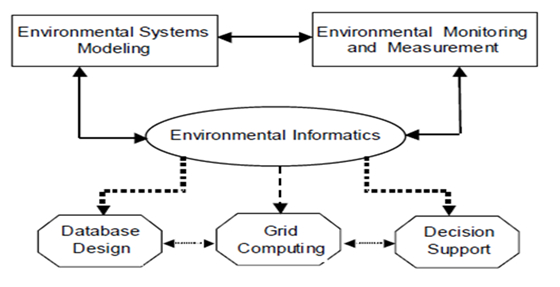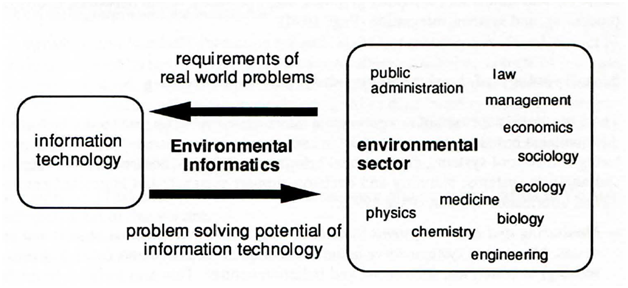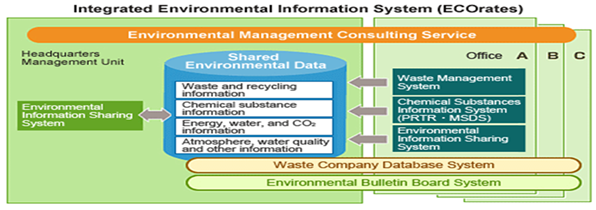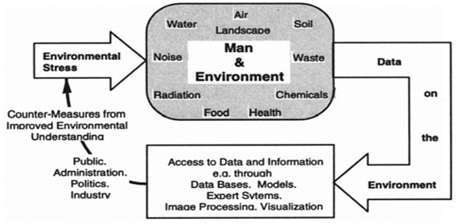Global development and the environmental situation are becoming more and more critical and dangerous. Driving factors are the uncontrolled growth of the world population combined with the increase in consumption in the developed countries. Both trends (more people, more consumption) have been viewed throughout history as unanimously positive.
The protection of our environment continues to be one of the greatest challenges in our industrialized societies. This challenge is addressing politics, economy, citizens, as well as technology and research. It is clear that the various problems in environmental protection, environmental planning, research and engineering can be only solved on the ground of a comprehensive and reliable information basis. State and dynamics of the environment are described by biological, physical, chemical, geological, meteorological, or social-economic data. This data is time and space dependent and addresses past or current states. The processing of this data and the production of meaningful information on the environment, on its stress factors and mutual influence mechanisms are fundamental for any kind of environmental planning and preventive measures. Therefore environmental problem solving is mainly an information processing activity handling a wide range of environmental data. Solutions to our environmental problems are strongly dependent on the quality of accessible information sources. Certainly, qualified information is a very critical factor in carrying out decisive political actions and in changing people´s attitudes on the environment. This information on environmental aspects is just as important for decisions on actions in environmental protection as for gaining knowledge in environmental research. (B. Page and V. Wohlgemuth. 2010)
Sustainable development is an important concept. However, it is difficult to operationalize and to make concrete. We will probably be confronted with quite sophisticated counter-arguments, and it might happen - as it has so often before - that uncoordinated development will actually lead to a state of affairs that is acceptable to no one. It is not at all clear what can be done to help to fight such a negative development. Certainly, information will be a very critical resource in changing attitudes and making decisive political actions possible (Friend 1991). The following trends in environmental information processing are crucial in this respect (Radermacher 1994; Hilty 1994): environmental monitoring by means of remote sensing and the coupling of data streams from all over the world, a policy for sharing and integrating environmental information across political and organizational boundaries, advanced model-based data analysis techniques, shifting the focus from data to dynamic system structure, industrial applications of environmental information processing, aiming at higher ecological efficiency (resource productivity) of the economic system. On the one hand, advanced computer applications obviously play a leading part in these developments. On the other hand, the growing field of environmental information processing is a great challenge to computer science methodologies and their applications. From this process of mutual stimulation, a new discipline has emerged, known as Environmental Informatics.
Environmental Informatics
Environmental informatics is the science of information applied to environmental science. As such, it provides the information processing and communication infrastructure to the interdisciplinary field of environmental sciences aiming at data, information and knowledge integration, the application of computational intelligence to environmental data as well as the identification of environmental impacts of information technology. The UK Natural Environment Research Council defines environmental informatics as the "research and system development focusing on the environmental sciences relating to the creation, collection, storage, processing, modelling, interpretation, display and dissemination of data and information". Environmental informatics emerged in early 1990 in Central Europe.
By environmental information, we mean data about the state of Earth’s biosphere (and associated spheres) and those processes affecting it. Environmental information differs from generic information in that its dimensionality always includes space and time, and its correct interpretation requires considerable scientific context (i.e., metadata) (James E. Frew and Jeff Dozier, 2012). Figure 1 describes the integrative structure between environ-mental systems modeling, environmental monitoring and measurement, and environmental informatics.

Figure 1: Components of environmental informatics and their relevant interactions.
An almost analogous situation can be observed today with regard to the environmental sector, leading to the formation of Environmental Informatics (Figure 2). However, the analogy to Medical Informatics does not perfectly hold, since the environmental sector is by itself an interdisciplinary research field. It incorporates knowledge from physics, chemistry, biology, ecology, sociology, economics, management, public administration, law, medicine, and other disciplines
Therefore, a special responsibility devolves upon Environmental Informatics in that it provides the information processing and communication infrastructure to this interdisciplinary field. An important and difficult task for Environmental Informatics is to serve as a catalyst for the integration of data, information, and knowledge from various sources in the environmental sector:
• Integrating data means overcoming the heterogeneity caused by the variety of operating and database systems, data formats and documentation conventions, program interfaces and software tools, used in different organizations and disciplines.
• Integrating information means to enable data to be interpreted meaningfully in different organizational and disciplinary contexts.
• Integrating knowledge is a long-term goal aiming at the compatibility of the conceptual frameworks of different disciplines and traditions.

Figure 2: Environmental Informatics supports an interdisciplinary field of Information Technology applications
Environmental Informatics has been maturing since the eighties. In Germany, this is documented by the proceedings of the annual conferences which have been organized by the working group informatics in Environmental Protection" in the German Association for Informatics (Gesellschaft fUr Informatik e.V., GI) since 1987. These conferences and a number of additional workshops have yielded a growing number of participants, projects, and publications (e.g., laeschke 1989; Pillmann 1990; Schwabl ;Hilty 1994). It is important to note that Environmental Informatics does not only explore the potential benefits of IT in solving environmental problems, but also considers (and tries to avoid) negative environmental impacts of information technology (Rolf 1992; Hilty 1994). Today, Environmental Informatics is an integral part of Applied Informatics. It provides methodological support for computer application in environmental protection by combining advanced research fields such as database systems, geographic information systems, modelling and simulation, computer graphics, user interfaces, neural networks, knowledge processing, and systems integration.
Trends recently focused
• Environmental monitoring by means of remote sensing and the combination of data streams from all over the world,
• A policy for sharing and integrating environmental information across political, technical and organizational boundaries (e.g. on the level of EU) making wide use of internet technology,
• Advanced model-based data analysis techniques, shifting the focus from data to dynamic system structures, industrial applications of environmental information processing, aiming at higher ecological efficiency of the economic system
Typology of Environmental Information Processing Systems
There is a broad spectrum of environmental information processing systems which can be differentiated based on the nature of the information to be processed. This includes monitoring and control systems, conventional information systems, computational evaluation and analysis systems, planning and decision support systems, and integrated environmental information systems:
Monitoring and control systems interact directly with environmental objects and processes. Monitoring systems serve in the automation of measurements (including remote sensing) in water, air, soil, noise, and radiation control. This also includes basic data analysis: time series data need to be aggregated, environmental objects need to be classified (e.g., in satellite images), and chemical substances need to be identified based on the measured data. Computerized process control is either directly employed in environmental technology such as in air emission control, sewage, sludge, or refuse processing, or used in production process automation with secondary effects on environmental protection (e.g., energy conservation, emission reduction). Monitoring and control systems often require the processing of vague information, e.g., using the evidence theory of Dempster and Shafer, fuzzy logic, or artificial neural networks.
Conventional information systems are systems for input, storage, structuring, integration, retrieval, and presentation of various kinds of environmental information such as raw measurement data, descriptions of environmental objects (such as geographic objects or chemical substances), as well as formal, semi-formal and informal documents such as environmental regulations or literature references. Spatial and temporal aspects often play an important role in the management of these kinds of information. Various kinds of software tools, including geographic information systems (GIS), hypermedia systems, etc., are necessary for coping with these requirements.
Computational evaluation and analysis systems support environmental data processing using complex mathematical-statistical analysis methods and modelling techniques. This includes simulating various environmental scenarios. Possible applications of these systems are the identification of possible causes of environmental impacts or the derivation of possible effects of different planning measures (e.g., causal models in forest damage research or forecast of emission loads over time and region).
Planning and decision support systems support decision makers by offering criteria for the evaluation of alternatives or for justifying decisions, e.g., for environmental impact analyses, for handling hazardous substances, for water resources management, or for technological risk assessment. For industrial applications, so-called computer-aided environmental information and management (CAEM) systems are currently being developed, which provide the information processing infrastructure for environmental management systems. This development is especially important in the context of the EU "Eco-management and Audit Scheme".
Integrated environmental information systems, as the last category mentioned, cannot be uniquely related to the system types mentioned above, since they consist of multiple components serving various purposes. It can be expected that integrated environmental information systems will be increasingly designed as distributed systems. The integration of various concepts for information processing, which is required for building these kinds of systems, presents a special challenge to the Applied Informatics, with similar importance to other application fields.

IEIS is an information system that, when applied in information sharing and communication, promotes legal compliance, risk avoidance, and environmentally conscious management through the introduction of IT to environmental management. IEIS is comprised of three subsystems: the Waste Management System, Environmental Information Sharing System and Chemical Substances Information System.
Interrelations with Methodologies and Research Fields of Informatics
DATABASE SYSTEMS AND GEOGRAPHICAL INFORMATION SYSTEMS
Database systems and methodology constitute the most basic part of informatics with regard to environmental applications (see Page, in this volume). Geographical information systems (GIS) are database systems specialized on spatially structured data. Because most environmental data is related to space and time, GIS are widely used as a basis for environmental information systems. However, GIS do not cope with the problem of handling large time series.
MODELING AND SIMULATION
Modeling and simulation techniques have been employed in the environmental sector for more than three decades. The first applications emerged from water resource management. Today, the following types of simulation models are used for advanced data analysis tasks, for decision support, planning, or for process control:
- Dispersion and quality models for air, water, or soil (e.g., Sydow 1994),
- Ecosystem models and models in ecological economics (e.g., Bossel 1994),
- Process models as a part of process control systems (e.g., Gilles 1988),
- Models for the prediction of traffic emissions (e.g., Freese 1994) and for planning purposes in "eco-logistics"
KNOWLEDGE-BASED SYSTEMS
More recently, attempts have been made for applying knowledge-based systems, in particular expert systems, to environmental information processing. Knowledge-based approaches are especially relevant to the interpretation of image data from monitoring systems such as aerial photographs and satellite sensor data.
Expert systems have been developed for decision support or planning applications in the following domains:
- Waste disposal, valuation of hazardous substances and contaminated sites,
- Environmental impact assessment and environmental planning,
- Application of environmental laws, regulations, and technical instructions,
- Advice in accidents and emergency situations with hazardous chemicals.
ARTIFICIAL NEURAL NETWORKS
Artificial neural networks, more precisely called connectionist models, have the ability to learn a limited range of tasks instead of being programmed. In Environmental Informatics, they are useful as a means to recognize patterns in large data sets.
Environmental Information Processing
Information technology has become absolutely essential for contemporary environmental management and protection in providing the required environmental information on the appropriate level of detail, completeness, accuracy and speed. Computer applications in environmental management and protection, however, are often lacking a sound conceptual and scientific basis. This is certainly not only a matter of applied Computer Science, but an interdisciplinary task where many scientific disciplines need to contribute (e.g. geo- and bio-sciences, environmental engineering, economics and law, measuring technology, administrative sciences, etc.). However, Computer Science or more specifically Informatics as the science of the fundamental methodology of information and knowledge processing, its applications and implications has the capability - and should therefore take over the responsibility - to play a central role in this interdisciplinary research process. Applied Informatics or Applied Computer Science, respectively cannot only provide a number of well-established techniques and tools, it can also bring forward the extension of its own methodology by making use of the complex and manifold environmental problem areas as a challenging test field for application and public needs oriented research.(Figure. 3)
Applications of Environmental informatics
Environmental informatics is of interest to people, organizations, and institutions devoted to the protection and preservation of ecosystems on a local, regional, and planetary scale. Computer-assisted environmental modelling can help scientists to develop long-term weather and climate forecasts. Examples include drought prediction, forecasts of the expected timing and extent of phenomena such as El Nino and La Nina, and estimates of the extent and impact of global warming. Environmental informatics can also be used to assist in the post-event management of environmental disasters, to manage urban development and growth, and to advise governments on policy planning and implementation.
Remote sensing has been widely used as a source of environmental information for ecological research. For example, in relation to biodiversity, studies have often sought to derive information on variables such as species richness and tried to facilitate biodiversity monitoring activities. The latter may be derived using a direct relationship between a measure of biodiversity and the remotely sensed response, often in the form of a vegetation index. Indeed many studies have used land cover data, often as a surrogate for data on habitat type, and frequently exploited the temporal dimension of remote sensing to monitor land cover dynamics. Remote sensing and GIS have the potential to make important contributions to biodiversity conservation. They may, for example, aid the prioritization of candidate locations for new reserves

Figure 3: Environmental problem solving seen as an information processing activity with feedback effects
Conclusion
The aim of Environmental Informatics is to bridge the gap between Information Technology and the environmental sector. On the one hand, advanced computer applications have a problem solving potential that must be developed into practical solutions for environmental problems. On the other hand, new and challenging requirements arise in the environmental sector that stimulates research and development in Informatics. The main challenge to Informatics is the complexity and heterogeneity of the environmental sector, demanding for innovative approaches to controlling complexity and to integrate existing data, information, and knowledge from various scientific disciplines and organizations. The role of Environmental Informatics should not be restricted to computer-based investigation of the present state of the environment. Although diagnosis is indispensable, it is useless if no therapy follows. Thus, Environmental Informatics should also accept the challenge to play an active role in the local and global transformations that will be necessary to approach sustainability. The role of Information Technology to build up agriculture and life of people in rural areas is well ascertained. The agricultural expansion system is dependent on IT to provide appropriate and location specific technologies for the farmers to furnish timely and expert’s advices to the farmers but also to enhance research and education system in agriculture. A silent revolution is taking place in the communication systems with the help of Internet in rural India. A lot of work has to be done to familiarize Internet usage to the farmers.
References:
1 B. Page and V. Wohlgemuth. (2010): Advances in Environmental Informatics: Integration of Discrete Event Simulation Methodology with ecological Material Flow Analysis for modelling eco efficient Systems. Procedia Environmental Sciences 2 696â€"705.
2 Bossel, H. (1994): Understanding Dynamic Systems: Shifting the Focus from Data to Structure. In: Hilty (1994), Volume I, pp. 63-75.
3 F. Recknagel.(2013): Current Scope, Case Studies and Future Directions of Ecological Informatics: Journal of Environmental Informatics 21(1) 3-11.
4 Freese, H.; Hauslein, A.; Isbam, I.; Klee, A.; Niederle, W.; Page, B.; Seidel, J. (1994): Ein Werkzeug zur Modellierung der Verkehrstrageremissionen auf der Basis einer tabellenorientierten, grafischen Simulationsmethodik. In: Hilty (1994a), Volume I, pp. 327-334.
5 Friedrich Recknagel. (2011): Ecological informatics: A discipline in the making: Ecological Informatics 6 1â€"3.
6 Friend, A.M.; Rapport, D.J. (1991): Evolution of macro-information systems for sustainable development. Ecological Economics, 3/1991, pp. 59-76.
7 Gilles, E. D.; Marquardt, W. (1988): ProzeBsimulation - ein Beitrag zum aktiven Umweltschutz. In: Beitrag der Mikorelektronik zum Umweltschutz, Proceedings. GME-Fachbericht. Berlin: vde-Verlag.
8 Hilty, L.M.; Martinssen, D.; Page, B. (l994): Designing a Simulation Tool for the Environmental Assessment of Logistical Systems and Strategies. In: Guariso, G.; Page, B. (eds.): Computer Support for Environmental Impact Assessment. IFIP transactions B- 16. Amsterdam: North-Holland.
9 Hilty, L.M.; Weiland, U. (I 994): Sustainable Cities - Opportunities and Risks of Information Technology. In: Brunnstein, K.; Raubold, E. (eds.): Proceedings of the 13th World Computer Congress. Volume II: Applications and Impacts. Amsterdam: Elsevier. pp. 613-618.
10 James E. Frew and Jeff Dozier. (2012): Environmental Informatics: Annu. Rev. Environ. Resour.. 37:449â€"72.
11 Lew Gerbilsky and Olena Staroseletska. (2002): Knowledge Integration, Environmental Informatics and Environmental Education: Environmental Communication in the Information Society - Proceedings of the 16th Conference.
12 Pillmann, W.; Jaeschke, A. (eds.) (1990): Informatik flir den Umweltschutz Proceedings 5. Symposium, Wien, September 1990, Informatik-Fachberichte 256, Berlin: SpringerVerlag.
13 Radermacher, F. J.; Riekert, W.-F.; Page, B.; Hilty, L. M. (1994): Trends in Enviromental Information Processing. In: Brunnstein, K.; Raubold (eds.): Applications and Impacts. IFIP transactions A-52. Amsterdam: North Holland.pp. 597-604.
14 Rolf, A.; Hilty, L.M. (1992): Informatik und Okologie - eine widersprlichliche Beziehung. Infotech 3/92, S. 6-8. Schwabl, A. Baumewerd-Ahlmann, and A. Waschkowski, R. (eds.) (1991): Rechnerunterstlitzung fur dies Umweltvertraglichkeitsprlifung - Stand und Perspektiven. Berlin: Erich Schmidt Verlag.
15 Sydow, A. (1994): Smog Analysis by Parallel Simulation. In: Hilty (1994), Volume I, pp.59-61
About Author / Additional Info:
I am currently pursuing Ph. D in Environmental sciences from Indian Agricultural Research Institute, New Delhi.